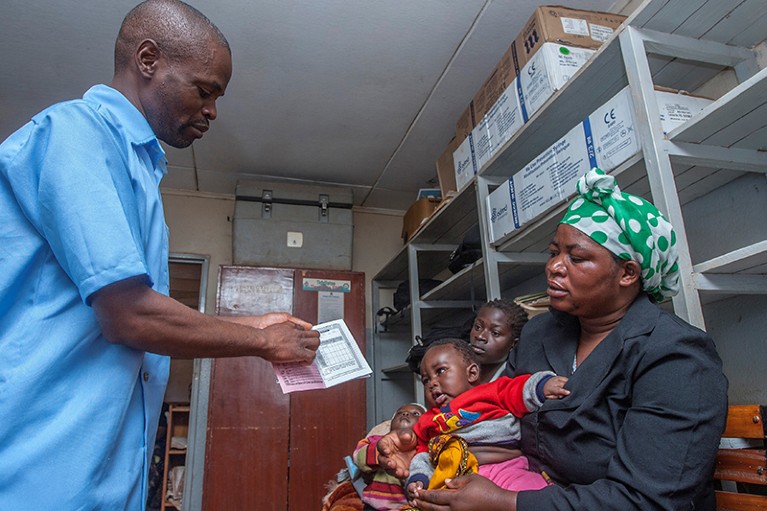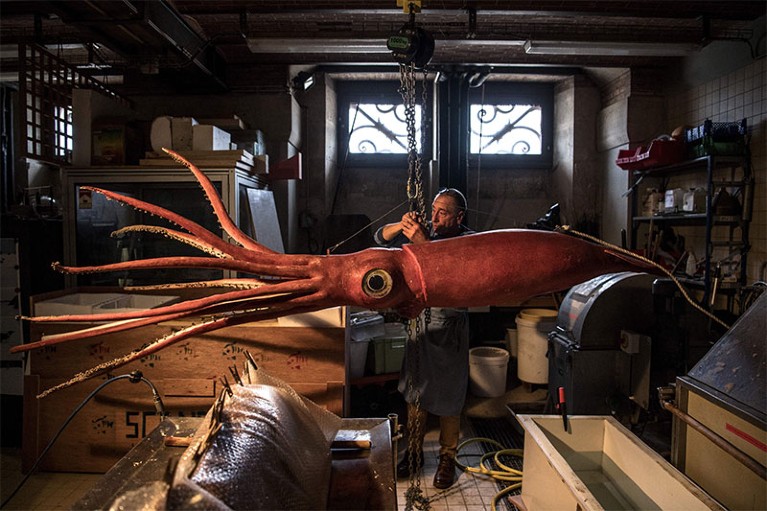Hello Nature readers, would you like to get this Briefing in your inbox free every day? Sign up here.

A pilot malaria-vaccination programme began in Malawi on 23 April.Credit:Amos Gumulira/AFP/Getty
Malaria vaccine rolled out in Africa — but doubts linger
A landmark pilot programme started this week to roll out the RTS,S malaria vaccine across Malawi, Ghana and Kenya. RTS,S is the first proven malaria vaccine, but it has its limits: it prevents only 40% of cases, it isn’t easy to distribute and it might be leap-frogged by more-effective drugs already in the pipeline. Many public-health experts agree that the vaccine’s epic cost — 32 years of work and more than US$700 million — highlights the need to rethink the whole process. “We are incredibly proud to see it rolled out,” says Thomas Breuer of GlaxoSmithKline, which makes the vaccine. But “this kind of endeavour can’t be repeated”.
Elsevier strikes open-access deal in Norway
After a year of talks, Dutch publishing giant Elsevier has struck its first mostly open-access deal with a group of Norwegian universities. The agreement will allow scientists to publish 1,850 open-access papers in Elsevier journals and give them unhindered access to 2,800 Elsevier titles. The Norway agreement does not include some prestigious Elsevier titles including the Cell Press journals and The Lancet, but it will still probably cover about 90% of Norwegian academics’ yearly publications in the company’s journals. Elsevier has been at loggerheads with organizations in Germany, Sweden, Hungary and the United States over the cost of this type of ‘read and publish’ deal.
Oceans harbour nearly 200,000 virus species
Every spoonful of seawater is filled with millions of viruses (most of which are harmless to humans, of course). Now, a survey from the shallows to the depths of nearly 80 sites around the world has increased our count of the number of virus species in the ocean by two orders of magnitude. This census is key to understanding how marine organisms interact and how viruses help to lock away carbon in the seas.
Mozambique hit by strongest storm in its history
Cyclone Kenneth has hit the north coast of Mozambique just five weeks after the country was devastated by Cyclone Idai. The latest storm is the strongest ever known to have struck the country, raising further fears for its short- and long-term effects on the population. “It is very difficult to imagine Houston and Puerto Rico in recovery mode and then having to face a category 3 hurricane four weeks later,” wrote atmospheric scientist Marshall Shepherd earlier this week in Forbes. “This is exactly what parts of Africa face in the next few days with far less wealth and adaptive capacity than the U.S.”
Meerkats: the ultimate altruists
Meerkats help each other with tasks such as feeding babies and digging burrows regardless of how closely related they are — seemingly counter to evolutionary theory, which predicts that animals will chip in only for their own kin. Researchers suspect that because all members of a meerkat group are closely related, it makes sense for them to be indiscriminately helpful.
Nature Research Highlights | 1 min read
Reference: The American Naturalist paper
Get more of Nature’s Research Highlights: short picks from the latest papers.
FEATURES & OPINION
Stop denying the risks of air pollution
Efforts in the United States and other countries to dismantle air-quality regulations do a disservice to the more than 90% of the world’s population that breathes dangerously polluted air, argues a Nature editorial. “Now is not the time to undermine efforts to clean air — it is time to strengthen them,” says Nature.
Protecting the paradoxical platypus
The platypus’ secretive, nocturnal, aquatic lifestyle has kept much of its nature a mystery, compared with Australia’s other iconic mammals. Now, tenacious biologists are beginning to discover more about the animal — a species so unusual it was once considered a hoax. “The biggest thing we’re learning is that platypuses are in trouble,” says biologist Joshua Griffiths.
BioGraphic | 8 min read (including some stunning photos)
Height heritability hidden in undiscovered genes
Researchers performed whole-genome sequencing of 21,620 people and found that the missing heritability for height and body mass index can be accounted for by rare gene variants, which typical genetic studies usually miss. This week’s Nature Podcast delves into the mystery, along with other top science stories of the week.
Subscribe to the Nature Podcast on iTunes or Google Podcast
BOOKS & ARTS

An installation from Katie Paterson’s exhibition A Place That Exists Only in Moonlight.Credit: Stephen White
Artist of deep time
Many of artist Katie Paterson’s works play with temporal and spatial immensities — such as an etching on black anodized aluminium of the locations of the 27,000 or so known stars that have reached the end of their life cycle. “We need a contemporary approach to what Stephen Hawking called ‘cathedral thinking’: far-reaching vision that is humanly relatable,” she tells interviewer Philip Ball.
When plague came to San Francisco
The story of the race to stop a plague epidemic in San Francisco that broke out in 1900 is a rich history of epidemiology, political wrangling and scientific denialism, writes medical historian Tilli Tansey. She reviews a pacy and gripping new book that makes “for sober reading in a world where Ebola clinics are being torched and anti-vaccination movements threaten a resurgence” in preventable diseases.
VIDEO OF THE WEEK
Read more: The largest study involving transgender people is providing long-sought insights about their health
SCIENTIFIC LIFE
Science in the Great White North
A multi-part Nature collection explores Canada’s science scene. The nation’s scientists have weathered changing fortunes in research funding under both liberal and conservative governments, and have found a voice to lobby for more attention in the process. Canadian ecologist Jean Polfus explains how the Dene Indigenous community’s knowledge of caribou species contributes to research on the threatened national icon. And Mona Nemer, Canada's chief scientific adviser, tells the Working Scientist podcast how she aims to strengthen science in the country.
Nature | Three-part collection
A simple approach to dating bones
Forensic anthropologist Ann Ross is looking at human remains in North Carolina with fresh eyes, hoping to help crack cold cases using modern forensics techniques. She tells Nature how scientists make skeletons tell a story.
IMAGE OF THE WEEK

Credit: Christophe Archambault/AFP/Getty
See more of our picture editors’ picks for best science photos of the month.
